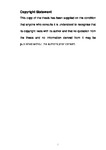Natural phenolic extracts from cardamom (Elettaria cardamomum), sumac (Rhus coriaria) and pomegranate (Punica granatum)- Potential application to control pathogenic bacteria in foods
| dc.contributor.supervisor | Kuri, Victor | |
| dc.contributor.author | Aal-Tay , Abass Fadhil Razoki | |
| dc.contributor.other | Faculty of Science and Engineering | en_US |
| dc.date.accessioned | 2015-06-12T09:52:06Z | |
| dc.date.available | 2015-06-12T09:52:06Z | |
| dc.date.issued | 2015 | |
| dc.identifier | 10320577 | en_US |
| dc.identifier.uri | http://hdl.handle.net/10026.1/3367 | |
| dc.description.abstract |
Abstract Food-borne disease is still a concern for both consumer and food industry in spite of the use of various preservation techniques. Plant extracts are becoming more popular as naturally occurring antibacterial agents. Antibacterial activity of cardamom, sumac, pomegranate, star anise and cranberry extracts and their minimum inhibitory concentration (MIC) against Escherichia coli, Staphylococcus aureus, Bacillus cereus, Salmonella typhimurium, Listeria monocytogenes and Clostridium perfringens were determined using agar well diffusion and broth dilution methods. Sumac and pomegranate alcoholic extracts and cardamom oleoresin showed strong antibacterial activity, and their MIC range were: for sumac (3-10 mgml-1), for pomegranate (6-12 mgml-1) and cardamom (3-25 mgml-1). Sumac alcoholic extract and cardamom oleoresin had higher phenolic content than other extracts. Positive correlations between the antibacterial activities of cardamom, sumac and pomegranate extracts and the level of phenolics were found. The mechanisms of action of the effective extracts were studied by scanning electron microscopy (SEM) observations of morphological alterations of the cell and the measurement of bacterial cell content release and intra and extracellular ATP. A significant (P<0.05) higher release of cell constituents was observed, on bacterial cells treated with effective extracts at the MIC when compared to controls. Both pomegranate and cardamom extracts dramatically decreased the intracellular ATP concentration, and increased the extracellular ATP concentration. All measurements suggested that selected extracts affected the cell membrane integrity, resulting in the loss of cell homeostasis and compromise of the cytoplasmic membranes. Experiments to understand combined effects of cardamom and pomegranate extracts and a range of environmental conditions of (temperature (25-35°C), pH (5-7) and NaCl (0-5%) were performed. Growth kinetic parameters of selected bacteria were computed using Baranyi and Robert’s model and a response surface analysis model (RSA). Precise and reliable data obtained from both models, predicted parameters for all tested bacteria showed a high correlation coefficient R2 > 0.081. Both extracts considerably reduced the growth rate and prolonged the lag time of all tested strains compared with control samples. Highest reduction on the growth rate was obtained when cardamom and pomegranate incorporated with 5% NaCl and pH 5. In conclusion, this study showed that selected extracts when used in conjunction with other hurdles can help to control food-borne bacteria. | en_US |
| dc.description.sponsorship | Ministry of higher education of Iraq | en_US |
| dc.language.iso | en | en_US |
| dc.publisher | Plymouth University | en_US |
| dc.subject | Antibacterial activity of natural phenolic compounds | en_US |
| dc.title | Natural phenolic extracts from cardamom (Elettaria cardamomum), sumac (Rhus coriaria) and pomegranate (Punica granatum)- Potential application to control pathogenic bacteria in foods | en_US |
| dc.type | Masters | en_US |
| plymouth.version | Full version | en_US |
Files in this item
This item appears in the following Collection(s)
-
01 Research Theses Main Collection
Research Theses Main


